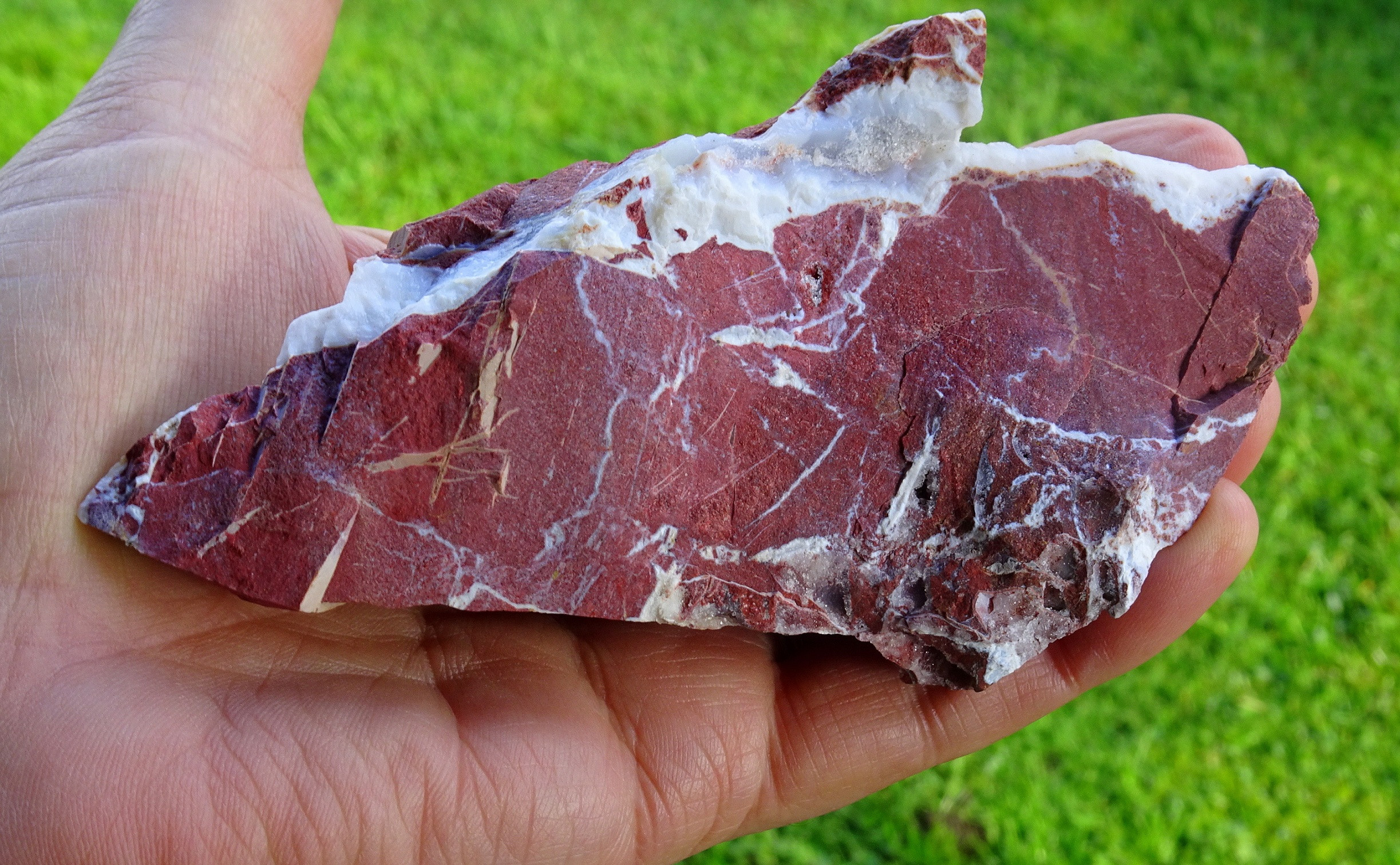Jasper Rock, a captivating and widely varied stone, has fascinated enthusiasts and collectors for centuries. From its vibrant colors to its intriguing patterns, jasper offers a wealth of geological interest and aesthetic appeal. This guide delves into the world of jasper rock, exploring its properties, origins, varieties, and how to appreciate its unique beauty, inspired by a personal journey with a special piece of jasper.
 Piece of Coromandel Peninsula jasper given to me by Jack Geerlings, showcasing its earthy tones and natural texture.
Piece of Coromandel Peninsula jasper given to me by Jack Geerlings, showcasing its earthy tones and natural texture.
What Exactly is Jasper Rock?
Jasper is a type of chalcedony, which itself is a microcrystalline form of quartz. This means that jasper is composed of silicon dioxide, but its crystal structure is so fine that it’s not visible to the naked eye. The term “cryptocrystalline” is often used to describe this hidden crystalline nature. What truly sets jasper rock apart is its opaqueness and the rich palette of colors it displays. These colors arise from various mineral inclusions present during its formation, most notably iron, which often imparts the characteristic red hues.
While sometimes confused with chert, true jasper rock distinguishes itself through its vibrant and interesting colors and patterns. According to Minerals.net, if a stone lacks these captivating visual elements, it’s more likely chert than jasper. Jasper’s formation typically occurs in volcanic cavities at low temperatures, where quartz crystals slowly develop.
 Close-up view of Diane's jasper stone after washing, revealing its initial rough texture and a silica band.
Close-up view of Diane's jasper stone after washing, revealing its initial rough texture and a silica band.
Jasper Rock Around the World and in New Zealand
Jasper rock is found globally, adorning beaches and riverbeds across various continents. In New Zealand, particularly the South Island, jasper is a common find. Beaches like Birdlings Flat in Canterbury, and Gemstone Beach and Riverton in Southland are renowned locations for discovering beautiful jasper stones. Its distinctive deep red color often makes it stand out against other beach stones.
One notable example is the large jasper rock displayed outside the Riverton Museum Te Hikoi in Southland, New Zealand. This public exhibit highlights the local geological heritage and the prevalence of jasper in the region.
 Jasper rock exhibited outdoors at Riverton Museum Te Hikoi, showcasing its size and natural form.
Jasper rock exhibited outdoors at Riverton Museum Te Hikoi, showcasing its size and natural form.
Varieties and Colors of Jasper Rock
The world of jasper rock is incredibly diverse in terms of color and pattern. While red jasper is perhaps the most well-known, this stone comes in a spectrum of hues including green, yellow, brown, and even blue and black. These colors are due to different mineral impurities within the quartz structure.
- Red Jasper: Its classic red color is owed to iron inclusions.
- Green Jasper: Often gets its green shades from chlorite or other silicate minerals.
- Yellow Jasper: Iron hydroxide impurities can create yellow and brownish-yellow tones.
- Orbicular Jasper: A fascinating variety characterized by spherical or orb-like patterns, often formed in rhyolite or tuff. These orbs are created by radial aggregates of quartz and feldspar crystals.
 Collection of various jasper rock types, showcasing the diverse colors and patterns found in this stone.
Collection of various jasper rock types, showcasing the diverse colors and patterns found in this stone.
Diane’s Jasper Rock: A Tumbling Journey
My niece, Diane, discovered a jasper stone in her Christchurch garden. Initially rough and with a pitted silica band, it was a promising find. Recognizing it as jasper, I offered to tumble it, hoping to reveal its hidden colors and beauty.
The tumbling process began with a coarse 220 silicon carbide grit for just over a week, followed by a soap and water tumble. This initial stage significantly improved the stone’s color, making the red more vibrant.
 Diane's jasper stone after the first stage of tumbling with 220 silicon carbide grit, showing enhanced color.
Diane's jasper stone after the first stage of tumbling with 220 silicon carbide grit, showing enhanced color.
Next, the jasper rock underwent a medium grit stage with 320 silicon carbide for another week, again followed by a soap tumble. While there was some surface improvement, the deeper pits remained.
 Diane's jasper stone after the 320 silicon carbide grit tumbling stage, indicating slight surface refinement.
Diane's jasper stone after the 320 silicon carbide grit tumbling stage, indicating slight surface refinement.
The final polishing stages involved pre-polish tin oxide, pro-polish tin oxide, and a borax burnishing tumble. Unfortunately, despite these efforts, the stone didn’t achieve a full polish. Lines of weakness emerged, a common characteristic of jasper that can make it challenging to polish perfectly. Jasper’s conchoidal fracture, similar to flint, and inherent brittleness can sometimes lead to chipping or cracking during tumbling.
 Diane's jasper stone after the final polishing stages, showing the stone's final appearance despite not achieving a full polish.
Diane's jasper stone after the final polishing stages, showing the stone's final appearance despite not achieving a full polish.
Despite not reaching a flawless polish, Diane’s jasper rock was undeniably transformed. The tumbling process cleaned the stone, enhanced its natural colors, and revealed the inherent beauty within. This journey highlights both the rewards and the challenges of working with jasper rock.
Appreciating Jasper Rock
Jasper rock is more than just a stone; it’s a piece of Earth’s history, shaped by geological processes over millennia. Whether found on a beach, in a museum, or unearthed in a garden, each piece of jasper is unique. Its variety in color and pattern makes it a favorite for collectors, jewelry makers, and anyone who appreciates natural beauty.
 Jasper stones found on Birdlings Flat beach, showcasing the natural environment where these rocks can be discovered.
Jasper stones found on Birdlings Flat beach, showcasing the natural environment where these rocks can be discovered.
From the deep reds to the vibrant greens and yellows, jasper rock offers a tangible connection to the natural world. Exploring and learning about jasper deepens our appreciation for the Earth’s geological wonders and the beauty hidden within seemingly ordinary stones.
References:
- Farndon, J. (2015). The Illustrated Guide to Rocks and Minerals. Lorenz Books.
- Polk, P. (2016). Collecting Rocks, Gems and Minerals (3rd ed.). Gem Guides Book Co.
- Minerals.net – Jasper
- Geology.com – Flint, Chert and Jasper
- Wikipedia – Chalcedony
- Mindat.org – Jasper
